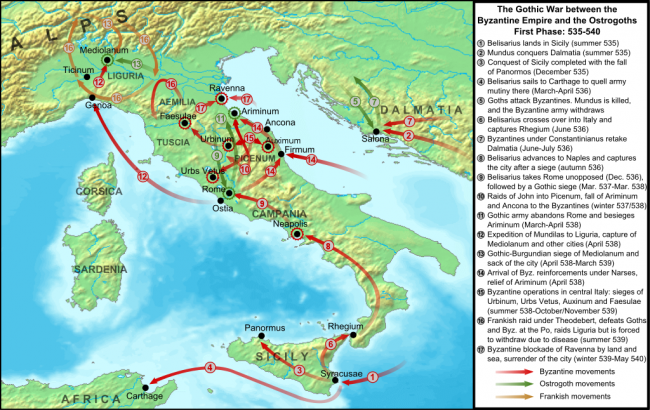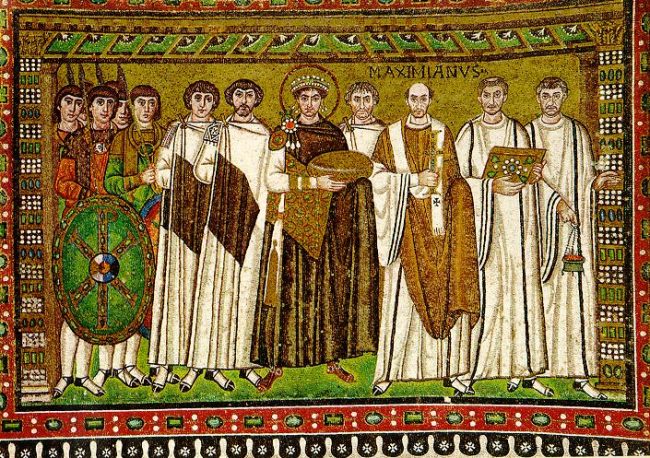Thanks to the works of the ancient writer Procopius, Flavius Belisarius is the best recorded military commander of his era.
At the time of his birth, around the year 500, the Roman Empire had changed. The Western half of the Empire had disintegrated and been conquered by a number of ‘Germanic’ tribes.
Most notably for the career of Belisarius, the Vandals had crossed the Straits of Gibraltar and conquered much of North Africa, including the major city of Carthage. Meanwhile in Europe, the Ostrogoths had crossed the Alps; Theodoric, the Ostrogoth king, ruled Italy, including the city of Rome.
 Watch Now
Watch NowJustinian I
The Eastern half of the Empire had survived the ‘barbarian’ invasions and a series of emperors had nursed the empire back to health. Of most importance to Belisarius was a man named Justinian, who was only a few years older than Belisarius.
Not long after inheriting the throne in 527, Justinian found himself able to launch a series of campaigns aimed at retaking territories in the West from the barbarians, especially Carthage and Africa from the Vandals, and Rome and Italy from the Ostrogoths.
Due to his desire to retake the old imperial capital, Justinian is sometimes seen as the ‘Last Roman Emperor’: his successors became increasingly Hellenised in their outlook.

Mosaic of Justin I. Image Credit: / Commons.
The perfect general
The man Justinian chose for the campaigns of reconquest was Belisarius. Belisarius was probably born in the town of Germania in Illyria. He became a member of the emperor’s personal bodyguard, possibly due in part to the fact that Justinian was born nearby, in Taor in northern Macedonia.
The Emperor obviously saw some military ability in the young man, as aged between 25 and 30 Belisarius was given a military command on the Eastern front.
He won a brilliant victory at the Battle of Dara over the Sassanid Persians in 530, but then was in turn defeated by them at Callinicum in 531.

The battleplan of the Battle of Dara.
Recalled to the capital, Belisarius was instrumental in bringing to an end the ‘Nika Riots’ in 532 by slaughtering the rioters, an act which proved his dedication to the Emperor.
At around the same time, he married Antonina, a personal friend of the Empress Theodora. It was these two events which guaranteed him command of the first expedition to the West, that to Africa.
Success after success
Previous attempts to conquer Vandal Africa had failed disastrously, but Belisarius landed unopposed and defeated the Vandals at the Battles of Ad Decimum and Tricamarum. The Vandal King Gelimer surrendered only nine months after Belisarius’ invasion.
Following this incredible feat, in 535 Belisarius was ordered to invade Ostrogothic Italy. As with the Allies in 1943, he quickly took Sicily before crossing to the mainland and moving north, capturing Naples and finally Rome. At this point the Ostrogoths replaced their king and the campaign descended into a stalemate.
Eventually, in 540, the Ostrogoths sent an embassy to Belisarius offering to surrender on condition that he rule over them as emperor. Belisarius accepted the terms but then refused the title. Despite this, after hearing of the offer the Emperor Justinian recalled Belisarius from Italy.

Map of the operations of the first five years of the war, showing the Roman conquest of Italy under Belisarius. Image credit: Cplakidas / Commons.
Transferred
Despite his suspicions, Justinian was forced to send Belisarius to the eastern frontier to fight the Persians again, but although Belisarius had some successes the victories were not on the same scale as those he had won in the west.
Eventually, he was recalled and charged with disloyalty, but the Empress Theodora intervened due to her friendship with Belisarius’ wife Antonina.
In the meantime, the Ostrogoths had reconquered much of Italy and Justinian sent Belisarius back to face them again. However, Justinian did not give Belisarius the troops he needed to win a final victory and the campaign again ended in stalemate.
Belisarius was recalled and despite a later minor victory over the Huns at the Battle of Melantias was never again entrusted with a major command. He died in 565, only a few months before Justinian. Together they had increased the size of the Roman Empire by almost 50%.

The enlargement of the Roman Empire possessions between the rise to power of Justinian (red, 527) and his and Belisarius’s death (orange, 565).
Why was Belisarius called ‘The Last of the Romans?’
The title ‘Last of the Romans’ can be applied to many men who lived between the start of the fifth and the end of the sixth century.
Examples include the general Aetius (d.454), Romulus Augustulus (r.475-476), Julius Nepos (also claimed the throne 474-475 and continued to do so until his death in 480) and, of course, Justinian (r. 527-565).
However the title ‘Last Roman General’ could be applied only to one of the above, Aetius: by this date Roman emperors no longer commanded troops in person.
On the other hand, there are several factors which can be used to claim this epithet for Belisarius. One is that he was born in Illyricum, previously acknowledged as being part of the Western Empire, ruled from Rome: under Constantine I (r.306/312/324-337) Illyricum was part of the ‘Prefecture of Italy, Illyricum and Africa’.
Only later did the region come under the rule of Constantinople. Consequently, his upbringing was probably largely Latin and ‘Western’ rather than specifically ‘Eastern’ – as with the Emperor Justinian.
 Listen Now
Listen NowLatin-speaker
Finally, as a native Latin speaker Belisarius followed in the tradition begun in the Roman Republican period of having Latin-speaking commanders leading Latin-speaking troops, and as such he would have been acknowledged as an heir by the Roman commanders of old.
Less than fifty years after the reign of Justinian the emperor Heraclius, (r.610-641) reformed the East, replacing Latin with Greek for official documents. Consequently, later commanders spoke Greek.

Belisarius may be the bearded figure on Emperor Justinian I’s right in the mosaic in the Church of San Vitale, Ravenna. Image Credit: Michleb / Commons.
Belisarius’ successor in Italy, and the man who finally brought the Ostrogothic war to a conclusion, was Narses – a ‘Romanised’ Armenian and a Eunuch, whose Latin was probably deemed unacceptable by the West Romans.
Due to his linguistic difficulties and his being a Eunuch, Narses would not have been acknowledged as ‘Roman’ by the previous Roman military leaders, and especially not by those such as Trajan who had helped to conquer the Empire.
Consequently, it is possible to surmise that Belisarius was indeed a great military leader in the Roman tradition and that, as he was followed by generals whose claim to being ‘Roman’ was dubious he does indeed deserve the title ‘Last Roman General’.
Ian Hughes is an historian who specialises in late Roman history. He is the author of several books including: Stilicho: The Vandal Who Saved Rome and Aetius: Attila’s Nemesis.
Belisarius: The Last Roman, was Ian’s first book and has recently been republished in a paperback edition by Pen and Sword Publishing, on 15 September 2019.
















